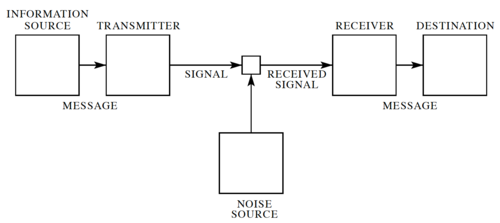Difference between revisions of "Shannon's Communication Theory"
| Line 42: | Line 42: | ||
Thus, we can conclude that <math>K\leq 1</math> since if this were not true, <math>K^m</math> would exceed <math>m\ell-m + 1</math> for large <math>m</math>. | Thus, we can conclude that <math>K\leq 1</math> since if this were not true, <math>K^m</math> would exceed <math>m\ell-m + 1</math> for large <math>m</math>. | ||
| − | ==== Entropy ==== | + | ==== Entropy and Coding ==== |
| + | Let <math>Q_i</math> be equal to: | ||
| + | |||
| + | {{NumBlk|::|<math>Q_i=\frac{r^{-\ell_i}}{K}</math>|{{EquationRef|6}}}} | ||
| + | |||
| + | We call the set of numbers <mathQ_i</math> ''pseudo-probabilities'' since <math>0<Q_i\leq1</math> for all <math>i</math>, and | ||
| + | |||
| + | {{NumBlk|::|<math>\sim_{i=1}^n Q_i=1</math>|{{EquationRef|7}}}} | ||
| + | |||
| + | If <math>p_i</math> is the probability of observing <math>a_i</math> in the data stream, then we can apply the Gibbs Inequality to get: | ||
| + | |||
| + | {{NumBlk|::|<math>\sim_{i=1}^n p_i\log_2\left(\frac{Q_i}{p_i}\right)\leq 0</math>|{{EquationRef|8}}}} | ||
== Shannon's Theory for Analog Channels == | == Shannon's Theory for Analog Channels == | ||
Revision as of 19:59, 14 September 2020
Contents
A First Look at Shannon's Communication Theory

In his landmark 1948 paper[1], Claude Shannon developed a general model for communication systems, as well as a framework for analyzing these systems. The model has three components: (1) the sender or source, (2) the channel, and (3) the receiver or sink. The model also includes the transmitter that encodes the message into a signal, the receiver, for decoding the signal back into a message, as well the noise of the channel, as shown in Fig. 1.
In Shannon's discrete model, the source provides a stream of symbols from a finite alphabet, , which are then encoded. The code is sent through the channel, which could be corrupted by noise, and when the code reaches the other end, it is decoded by the receiver, and then the sink extracts information from the steam of symbols.
Note that sending information in space, e.g. from here to there is equivalent sending information in time, e.g. from now to then. Thus, Shannon's theory applies to both information transmission and information storage.
Shannon's Noiseless Coding Theorem
One very important question to ask is: "How efficiently can we encode the information that we want to send through the channel?" To answer this, let us assume: (1) the channnel is noiseless, and (2) the receiver can accurately decode the symbols transmitted through the channel. First, let us define a few things.
A code is defined as a mapping from a source alphabet to a code alphabet. The process of transforming a source message into a coded message is coding or encoding. The encoded message may be referred to as an encoding of the source message. The algorithm which constructs the mapping and uses it to transform the source message is called the encoder. The decoder performs the inverse operation, restoring the coded message to its original form.
A code is distinct if each codeword is distinguishable from every other, i.e. the mapping from source messages to codewords is one-to-one. A distinct code is uniquely decodable (UD) if every codeword is identifiable when immersed in a sequence of codewords. A uniquely decodable code is a prefix code (or prefix-free code) if it has the prefix property, which requires that no codeword is a proper prefix of any other codeword. Prefix codes are instantaneously decodable, i.e. they have the desirable property that the coded message can be parsed into codewords without waiting for the end of the message.
The Kraft-McMillan Inequality
Let be the alphabet of the channel, or in other words, the set of symbols that can be sent through the channel. Thus, encoding the source alphabet can be expressed as a function, , where is the set of all possible finite strings of symbols (or codewords) from .
Let where , i.e. the length of the string of channel symbols encoding the symbol .
A code with lengths is uniquely decodable if and only if:
-
(1)
-
The proof of the Kraft-McMillan Inequality is interesting since it starts with evaluating :
-
(2)
-
Let . Thus, the minimum value of is , when all the codewords are 1 bit long, and the maximum is , when all the codewords have the maximum length. We can then write:
-
(3)
-
Where is the number of combinations of codewords that have a combined length of . Note that the number of distinct codewords of length is . If this code is uniquely decodable, then each sequence can represent one and only one sequence of codewords. Therefore, the number of possible combinations of codewords whose combined length is cannot be greater than , or:
-
(4)
-
We can then write:
-
(5)
-
Thus, we can conclude that since if this were not true, would exceed for large .
Entropy and Coding
Let be equal to:
-
(6)
-
We call the set of numbers <mathQ_i</math> pseudo-probabilities since for all , and
-
(7)
-
If is the probability of observing in the data stream, then we can apply the Gibbs Inequality to get:
-
(8)
-
































